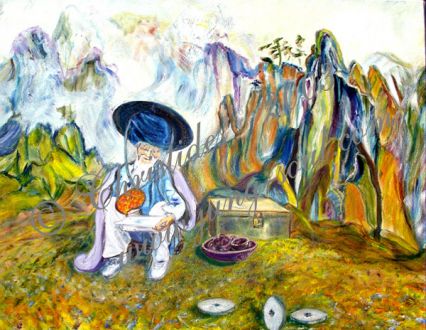LANGUAGES

LANGUAGES

The name Zhou yi literally means the "changes". The "changes" involved have been interpreted as the transformations of hexagrams, of their lines, or of the numbers obtained from the divination.
Book of Changes
The I Ching, also known as the Classic of Changes or Book of Changes in English, is an ancient divination text and the oldest of the Chinese classics. Traditionally, the Zhou yi is associated with the legendary world ruler Fu Xi. According to the canonical Great Commentary, Fu Xi observed the patterns of the world and created the eight trigrams (Chinese: 八卦; pinyin: bāguà), "in order to become thoroughly conversant with the numinous and bright and to classify the myriad things."
The Zhou yi itself does not contain this legend and indeed says nothing about its own origins. The Rites of Zhou, however, also claims that the hexagrams of the Zhou yi were derived from an initial set of eight trigrams. During the Han dynasty there were various opinions about the historical relationship between the trigrams and the hexagrams.
The basic unit of the Zhou yi is the hexagram (卦 guà), a figure composed of six stacked horizontal lines (爻 yáo). Each line is either broken or unbroken. The received text of the Zhou yi contains all 64 possible hexagrams, along with the hexagram's name (卦名 guàmíng), a short hexagram statement (彖 tuàn),[note 3] and six line statements (爻辭 yáocí). The statements were used to determine the results of divination, but the reasons for having two different methods of reading the hexagram are not known, and it is not known why hexagram statements would be read over line statements or vice versa.

PHOTO: COBOLTNET.DEVIANTART.COM
The names of the hexagrams are usually words that appear in their respective line statements, but in five cases (2, 9, 26, 61, and 63) an unrelated character of unclear purpose appears. The hexagram names could have been chosen arbitrarily from the line statements, but it is also possible that the line statements were derived from the hexagram names. The line statements, which make up most of the book, are exceedingly cryptic.
Each line begins with a word indicating the line number, "base, 2, 3, 4, 5, top", and either the number 6 for a broken line, or the number 9 for a whole line. Hexagrams 1 and 2 have an extra line statement, named yong. Following the line number, the line statements may make oracular or prognostic statements. Some line statements also contain poetry or references to historical events.
RELATED ARTICLES
OTHER ARTICLES

ICHING & REIKI
Angelic ReikiAngelic Reiki is a safe, natural, high frequency, multidimensional system of Angelic Healing and consciousness expansion that allows connection through the Angelic Kingdom of Light to your Soul energy in order to bring through powerful healing; yet it is simple to learn, easy to use and a delight to receive.

ICHING & REIKI
Reiki and HerbsYou must be wondering how Reiki and herbs can be connected and used on seeing the title of the topic, but from my personal experience herbs play a major role in opening the chakras, balancing or harmonizing them.

ICHING & REIKI
Inspirational Quotes from Lao Tzu’s Tao Te ChingLao Tzu (The Old Master), also know as Lao Tse, Lao Tsu or Lao Zi, is a personality clouded by doubt and historical uncertainty, as far as facts about his life are concerned. Historians and scholars have been trying for centuries to create an accurate biography for Lao Tzu without much success, as two or three historical figures seem to identify with him.
OLDER ARTICLES
LATEST FORUM UPDATES
tatamata, Monday, 21.11.2016 / 9:01
NEW ARTICLES
POPULAR ARTICLES